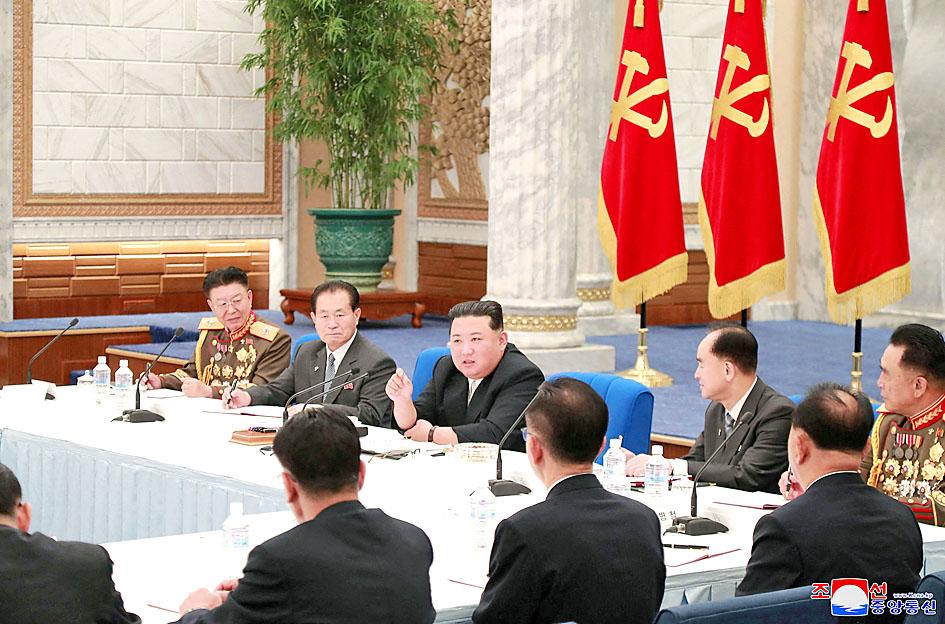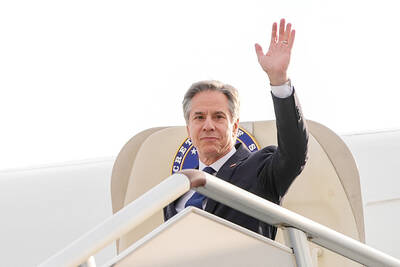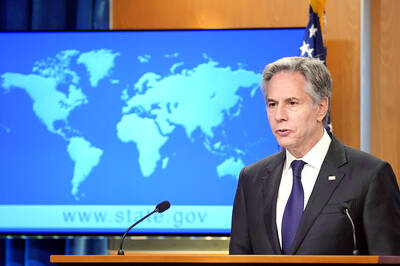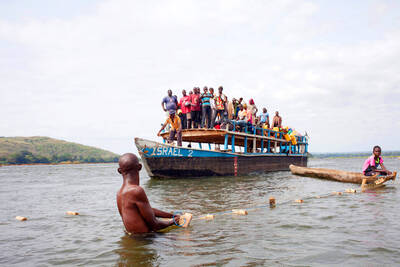North Korea discussed assigning additional duties to its frontline army units at a key military meeting, state media said yesterday, suggesting that the country might deploy battlefield nuclear weapons targeting South Korea along the rivals’ tense border.
The discussion comes as South Korean officials said North Korea has finished preparations for its first nuclear test in five years, as part of possible efforts to build a warhead to be mounted on short-range weapons capable of hitting targets in South Korea.
During an ongoing meeting of the Central Military Commission of the ruling Workers’ Party on Wednesday, North Korean leader Kim Jong-un and other top military officers discussed “the work of additionally confirming the operation duties of the frontline units of the Korean People’s Army and modifying the operation plans,” the official Korean Central News Agency said.

Photo: Reuters
Kim also ordered steps to be taken to “enhance the operational capabilities of the frontline units,” the agency said, showing a photo of what appeared to be a map of the Korean Peninsula’s eastern coast, including border sites, near the conference table.
“I can assess the issue of forward-deploying tactical nuclear weapons [was] discussed at the meeting in an in-depth manner,” said Cheong Seong-chang, a senior analyst at South Korea’s private Sejong Institute.
When North Korea in April test-fired a new type of tactical guided weapon, South Korea said the weapon has “great significance in drastically improving the firepower of the front line, long-range artillery units, enhancing the efficiency in the operation of [North Korea’s] tactical nukes and diversification of their firepower missions.”
Its use of the words “tactical nukes” suggested that the weapon is likely short-range and armed with a nuclear warhead. Some experts said that North Korea intends to deploy such weapons to threaten key facilitates in South Korea, including US military bases.
Later in April, Kim said North Korea might pre-emptively use its nuclear weapons if threatened.
The possibility of North Korea having an escalatory nuclear doctrine could pose a greater concern for South Korea, Japan and the US.
Kim convened the military commission meeting earlier this week to confirm “crucial and urgent tasks” to expand military capabilities and implement key defense policies, state media said.
Cheong said that North Korea is expected to perform its seventh nuclear test after the meeting, adding that its third test in 2013 also came days after another commission meeting.
Kim has convened 17 meetings of the military commission since he took power in late 2011, but this is the first to last two days or longer, Cheong said.
Wednesday was the second-day session, with indications showing that the meeting continued yesterday.
Earlier this year, North Korea test-launched a spate of missiles with potential ranges placing the US mainland and Asian allies such as South Korea and Japan within striking distances.
North Korea has intercontinental ballistic missiles potentially capable of reaching the US, but experts have said that the country still needs to master re-entry capability and other technologies to make them functioning weapons.
Some experts have said that North Korea’s weapons launches were meant to modernize its weapons systems and boost its leverage in future negotiations with the US to win sanctions relief and other concessions.
South Korean and US officials have warned North Korea that it would face consequences if it goes ahead with a nuclear test.
However, divisions between permanent members of the UN Security Council make the prospects for fresh punitive international sanctions unclear. Russia and China this year vetoed US-sponsored resolutions that would have increased sanctions, insisting that Washington should focus on reviving dialogue.

‘IN A DIFFERENT PLACE’: The envoy first visited Shanghai, where he attended a Chinese basketball playoff match, and is to meet top officials in Beijing tomorrow US Secretary of State Antony Blinken yesterday arrived in China on his second visit in a year as the US ramps up pressure on its rival over its support for Russia while also seeking to manage tensions with Beijing. The US diplomat tomorrow is to meet China’s top brass in Beijing, where he is also expected to plead for restraint as Taiwan inaugurates president-elect William Lai (賴清德), and to raise US concerns on Chinese trade practices. However, Blinken is also seeking to stabilize ties, with tensions between the world’s two largest economies easing since his previous visit in June last year. At the

UNSETTLING IMAGES: The scene took place in front of TV crews covering the Trump trial, with a CNN anchor calling it an ‘emotional and unbelievably disturbing moment’ A man who doused himself in an accelerant and set himself on fire outside the courthouse where former US president Donald Trump is on trial has died, police said yesterday. The New York City Police Department (NYPD) said the man was declared dead by staff at an area hospital. The man was in Collect Pond Park at about 1:30pm on Friday when he took out pamphlets espousing conspiracy theories, tossed them around, then doused himself in an accelerant and set himself on fire, officials and witnesses said. A large number of police officers were nearby when it happened. Some officers and bystanders rushed

Beijing is continuing to commit genocide and crimes against humanity against Uyghurs and other Muslim minorities in its western Xinjiang province, U.S. Secretary of State Antony Blinken said in a report published on Monday, ahead of his planned visit to China this week. The State Department’s annual human rights report, which documents abuses recorded all over the world during the previous calendar year, repeated language from previous years on the treatment of Muslims in Xinjiang, but the publication raises the issue ahead of delicate talks, including on the war in Ukraine and global trade, between the top U.S. diplomat and Chinese

RIVER TRAGEDY: Local fishers and residents helped rescue people after the vessel capsized, while motorbike taxis evacuated some of the injured At least 58 people going to a funeral died after their overloaded river boat capsized in the Central African Republic’s (CAR) capital, Bangui, the head of civil protection said on Saturday. “We were able to extract 58 lifeless bodies,” Thomas Djimasse told Radio Guira. “We don’t know the total number of people who are underwater. According to witnesses and videos on social media, the wooden boat was carrying more than 300 people — some standing and others perched on wooden structures — when it sank on the Mpoko River on Friday. The vessel was heading to the funeral of a village chief in